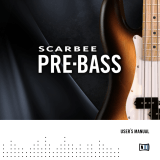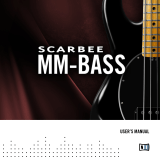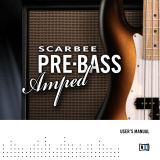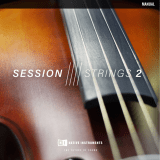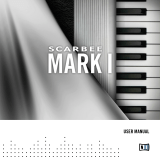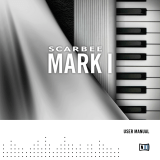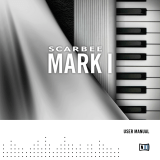Page is loading ...

Manual

The information in this document is subject to change without notice and does not represent a
commitment on the part of Native Instruments GmbH. The software described by this docu-
ment is subject to a License Agreement and may not be copied to other media. No part of this
publication may be copied, reproduced or otherwise transmitted or recorded, for any purpose,
without prior written permission by Native Instruments GmbH, hereinafter referred to as Native
Instruments.
Rickenbacker ®, the "R" Design, Triangular Name Crescent Design, RIC, and logotypes are
among the trademarks and service marks in the United States and other countries of Ricken-
backer International Corporation.
“Native Instruments”, “NI” and associated logos are (registered) trademarks of Native Instru-
ments GmbH.
Mac, Mac OS, GarageBand, Logic, iTunes and iPod are registered trademarks of Apple Inc.,
registered in the U.S. and other countries.
Windows, Windows Vista and DirectSound are registered trademarks of Microsoft Corporation
in the United States and/or other countries.
All other trade marks are the property of their respective owners and use of them does not im-
ply any affiliation with or endorsement by them.
Document authored by: Thomas Hansen Skarbye, Christoph Laue
Software version: 1.0 (11/2012)
Special thanks to the Beta Test Team, who were invaluable not just in tracking down bugs, but
in making this a better product.
Disclaimer

Table of Contents
1 Welcome to RICKENBACKER® BASS ...........................................................................
6
1.1 About the Rickenbacker® 4003 ................................................................................................. 6
1.2 About RICKENBACKER® BASS .................................................................................................... 7
2 The RICKENBACKER® BASS Interface .........................................................................
9
2.1 Info Pane (Tooltips) .................................................................................................................... 9
2.2 Presets ....................................................................................................................................... 10
2.3 Bass Settings ............................................................................................................................. 13
2.4 The Amplifier .............................................................................................................................. 14
2.5 The Cabinets .............................................................................................................................. 16
2.6 The Tape Effect ........................................................................................................................... 18
2.7 The Compressor .......................................................................................................................... 20
2.8 The Equalizer (EQ) ...................................................................................................................... 21
3 Using RICKENBACKER® BASS ....................................................................................
23
3.1 Playing Bass Notes on a Keyboard .............................................................................................. 23
3.1.1 Automatic String Selection ........................................................................................ 23
3.1.2 Manual String Selection ............................................................................................ 24
3.2 Key Layout .................................................................................................................................. 25
3.2.1 Key Switches .............................................................................................................. 25
3.2.2 Hand Playing Position Key Switch .............................................................................. 28
3.3 Articulations ............................................................................................................................... 28
3.3.1 Sustains .................................................................................................................... 28
3.3.2 Scrapes ..................................................................................................................... 29
3.3.3 Mutes and Harmonics ................................................................................................ 29
3.3.4 Hammer-On and Pull-Off ........................................................................................... 29
3.3.5 Fast Grace Note Up .................................................................................................... 30
3.3.6 Slides ........................................................................................................................ 30
Table of Contents
Scarbee Rickenbacker Bass - Manual - 4

3.3.7 Buzz Trills & Trills ...................................................................................................... 31
3.3.8 Pickup/String Clap .................................................................................................... 31
3.4 Automatically Triggered Samples ............................................................................................... 32
3.5 Playing Techniques ..................................................................................................................... 32
3.5.1 Auto Stroke Detection ................................................................................................ 32
3.5.2 Force Hammer On / Pull Off ....................................................................................... 33
3.5.3 Cross Hammering ...................................................................................................... 33
3.5.4 Chord Slides .............................................................................................................. 34
3.5.5 Sustaining Notes ....................................................................................................... 34
3.5.6 Vibrato ....................................................................................................................... 35
3.5.7 Instrument Reset ....................................................................................................... 35
3.6 Sound and Performance Settings ............................................................................................... 36
3.6.1 Sound Settings .......................................................................................................... 37
3.6.2 Performance Settings ................................................................................................ 38
4 Credits ......................................................................................................................
40
Table of Contents
Scarbee Rickenbacker Bass - Manual - 5

1 Welcome to RICKENBACKER® BASS
When Native Instruments and I discussed the next project after FUNK GUITARIST, we decided
that it was time to do a picked bass, as we had never done such an instrument before. And of
course the first choice of bass was the legendary Rickenbacker® 4003!
Numerous bass players in classic 1970s hard rock groups, as well as some of the most influen-
tial progressive musicians, have used this bass. Punk bands loved it in the 1980s, and many
modern bands, from pop to alternative rock, are using it today.
I have been admiring the sound, but also the design of Rickenbacker® Guitars and basses for
decades now, and finally was fortunate to find a particularly nice Rickenbacker® 4003 bass
some years ago. I fell in love with this instrument when I played it for the first time, and I still
love to look at it and play it as much as I can — which has made recording it a pleasure. I
hope you will enjoy using RICKENBACKER® BASS as much as I enjoyed creating it!
Yours truly,
Thomas Hansen Skarbye
1.1 About the Rickenbacker® 4003
The sound of the Rickenbacker® 4003 bass is big, with a long sustain. Its rich overtones per-
fectly complement the tight, yet deep low end. Three different pickup settings allow for very
different timbres. The bass was recorded using the famous 'Rick-O-Sound' stereo outputs.
The palm-muted Rickenbacker® sound also present in RICKENBACKER® BASS was very diffi-
cult to capture and required some extra care, as the palm pressure changes the pitch and also
affects the overall muting level. The result is an amazingly fat sound that, when using the neck
pickup setting, resembles a synthesizer bass.
The pickups and electronics of the Rickenbacker® 4003 bass are very powerful and sensitive
— almost like microphones! Therefore the recording location had to be chosen wisely, with any
possible source of electromagnetic interference excluded; special monitor speakers with ultra-
low electromagnetic interference were purchased for this project. Funnily, the pickups even
Welcome to RICKENBACKER® BASS
About the Rickenbacker® 4003
Scarbee Rickenbacker Bass - Manual - 6

captured conversations held in the studio, so recording had to take place in complete silence.
Finally, the studio furniture was optimized in order to create a completely noiseless environ-
ment.
The Rickenbacker® 4003 was stringed with Rotosound® Swing Bass 66 (stainless steel)
round-wound strings to get the classic sound heard on numerous rock albums. The full length
of each string was sampled in order to reproduce the timbre changes that occur when the play-
er's fingers move between low and high frets, and to capture all the natural overtones. Instead
of recording the bass through an amplifier and loudspeaker cabinet, a DI input was used to
retain maximum flexibility for subsequent sound shaping.
1.2 About RICKENBACKER® BASS
RICKENBACKER® BASS features an extensive selection of playing techniques, for example:
▪ Picked style
▪ Open and palm-muted playing
▪ Sustains — up-strokes and down-strokes
▪ Normal mutes and harmonic mutes
▪ Harmonics
▪ Hammer-on & pull-off
▪ Fast grace notes
▪ Slides
▪ Trills — whole-note/half-note
▪ Buzz trills — whole-note/half-note
▪ Cross-hammering
▪ Chords
▪ Chord slides
▪ Percussive slides
▪ Releases
Welcome to RICKENBACKER® BASS
About RICKENBACKER® BASS
Scarbee Rickenbacker Bass - Manual - 7

You can conveniently use all these techniques while playing RICKENBACKER® BASS live: Ex-
cept for the trills and cross-hammering, you can trigger all of the articulations and techniques
above without the need for any key switches.
RICKENBACKER® BASS offers numerous advanced features to support your playing:
▪ String selection
▪ A fretboard display that is updated as you play
▪ Automatic stroke detection
▪ Chord recognition that ensures correct string selection even if the chord notes don't arrive
at exactly the same time
▪ Trills/buzz trills with automated re-triggering of pull-offs/slide downs
▪ String scrape simulation, using about 1000 different samples in an advanced round-robin
system
Furthermore, the script enables you to configure the KONTAKT Instrument: You can adjust in-
strument and effects settings, load and store presets, and access key switch mapping informa-
tion within the Instrument's Performance View.
Welcome to RICKENBACKER® BASS
About RICKENBACKER® BASS
Scarbee Rickenbacker Bass - Manual - 8

2 The RICKENBACKER® BASS Interface
2.1 Info Pane (Tooltips)
Reference information describing controls and other user interface elements of RICKENBACK-
ER® BASS is available in KONTAKT's Info Pane. To access this information:
1. Click the Info icon in KONTAKT's Toolbar to enable display of Info Pane content.
2. Hover your mouse over an element in the user interface.
→
The description of the element will be displayed in the Info Pane at the bottom of the
KONTAKT window.
The RICKENBACKER® BASS Interface
Info Pane (Tooltips)
Scarbee Rickenbacker Bass - Manual - 9

The Info Pane at the bottom of the KONTAKT window
2.2 Presets
Presets contain all of the instrument's settings, such as the selected pickup, the bass's volume
and tone settings, as well as all the effects settings from Amplifier, Cabinet, Compressor, Tape
and EQ.
The RICKENBACKER® BASS Interface
Presets
Scarbee Rickenbacker Bass - Manual - 10

Loading a Preset
The Preset menu
►
To load a preset, click on the drop-down menu in the PRESET area in the top-left corner
of the RICKENBACKER® BASS Performance View, then select a preset from the list.
Saving a Preset
The Save button
The RICKENBACKER® BASS Interface
Presets
Scarbee Rickenbacker Bass - Manual - 11

To save a preset:
1. Click in the preset name display and enter a name for the preset.
2. Click the diskette symbol next to the PRESET label.
This will save all of the instrument's settings, such as the selected pickup, the bass's volume
and tone settings, as well as all the effects settings from Amplifier, Cabinet, Compressor, Tape
and EQ as a new preset with the given name.
►
To export a preset, press [CTRL] + click (Windows), or [CMD] + click (Mac OS X).
►
To import a preset, press [ALT] + click.
When importing a preset, you need to copy the name from the original file and paste it into
the text field. Then click to save the preset.
►
To move a preset upwards in the preset list, press [SHIFT] + click.
►
To move a preset downwards in the preset list, press [SHIFT] + [ALT] + click.
Deleting a Preset
The Delete button
►
To delete a preset, click the round icon next to the diskette symbol.
Note that Undo is not available for this function, i.e. you cannot restore presets after you
have deleted them.
Navigating the Preset List with the Arrow Buttons
The Arrow buttons
You can navigate the presets step-wise by clicking the Arrow buttons:
The RICKENBACKER® BASS Interface
Presets
Scarbee Rickenbacker Bass - Manual - 12

►
To select the previous preset in the preset list, click the arrow pointing to the left.
►
To select the next preset in the preset list, click the arrow pointing to the right.
2.3 Bass Settings
►
To show or hide the Bass settings, click on the body of the bass.
The Bass settings
This will provide access to the settings below:
The RICKENBACKER® BASS Interface
Bass Settings
Scarbee Rickenbacker Bass - Manual - 13

▪ Neck Pickup Volume: Use the VOLUME control to set the output level of the Neck pickup.
▪ Neck Pickup Tone: Use the TONE control to set the tone of the Neck pickup. When turned
all the way clockwise, it is fully open, thus creating a brighter sound with more overtones
present.
▪ Pickup Selector: Selects Neck pickup (NECK position), Neck and Bridge pickups (BOTH
position), or Bridge pickup (BRIDGE position).
▪ Rick-O-Sound Switch: The Rick-O-Sound feature allows for stereo panning of the Neck and
Bridge pickups. This creates a very fat sound. In this mode the Amplifier (see section
↑2.4, The Amplifier for details) works in stereo. To enable the Rick-O-Sound feature, set
the switch labeled RICK-O-SOUND to the ON position.
▪ Bridge Pickup Volume: Use the VOLUME control to set the output level of the Bridge pick-
up.
▪ Bridge Pickup Tone: Use the TONE control to set the tone of the Neck pickup. When
turned all the way clockwise, it is fully open, thus creating a brighter sound with more
overtones present.
2.4 The Amplifier
►
To show or hide the Amplifier settings, click on the amplifier head.
The RICKENBACKER® BASS Interface
The Amplifier
Scarbee Rickenbacker Bass - Manual - 14

The Amplifier settings
This will provide access to the settings below:
▪ Amplifier On/Off: Use the on/off switch in the top-left corner of the Amplifier panel to
switch the Amplifier effect on and off.
▪ Gain Switch: Use the switch labeled GAIN to switch the Amplifier's input stage between
low-gain (LOW) and hi-gain (HI) mode. Hi-gain mode significantly increases the pre-amp's
gain potential.
▪ Master: Use the MASTER control to set the Amplifier's master volume.
▪ Preamp: Use the PREAMP control to set the preamp's gain. Turning the control clockwise
adds drive, distortion and edge to the sound.
The RICKENBACKER® BASS Interface
The Amplifier
Scarbee Rickenbacker Bass - Manual - 15

▪ Bass: Use the BASS control to set the low-frequency response.
▪ Mid: Use the MID control to set the midrange frequency response.
▪ Treble: Use the TREBLE control to set the high frequency response.
▪ Presence: Use the PRESENCE control to boost the frequency response in the upper mid-
range.
2.5 The Cabinets
►
To show or hide the Cabinet settings, click on the loudspeaker cabinet.
The RICKENBACKER® BASS Interface
The Cabinets
Scarbee Rickenbacker Bass - Manual - 16

The Cabinet settings
This will provide access to a selection of cabinet and microphone setups
►
Cabinets On/Off: Use the on/off switch in the top-left corner of the Cabinets panel to
switch the Cabinets effect on and off.
►
To select a cabinet setup, click on one of the pictures in the Cabinets settings. These set-
ups are available:
▪ 4x12 UK 70s / 8x10 Bass Pro: Dual-cabinet setup featuring a British vintage 4 x 12" cab-
inet and the classic “roadie's nightmare” 8 x 10" cabinet.
▪ 4x10 Tweed: American vintage 4 x 10" cabinet.
The RICKENBACKER® BASS Interface
The Cabinets
Scarbee Rickenbacker Bass - Manual - 17

▪ 4x10 Bass Alu: Modern 4 x 10" bass cabinet equipped with speakers using aluminum
cones.
▪ 4x12 UK 80s: Black British 4 x 12" cabinet made in the 1980s.
▪ 8x10 Bass Pro Con 30 mic: Classic 8 x 10" cabinet, recorded using a condenser micro-
phone.
▪ 8x10 Bass Pro Dyn 6 mic: Classic 8 x 10" cabinet, recorded using a dynamic micro-
phone.
▪ 1x12 Tweed / 8x10 Bass Pro: Dual-cabinet setup featuring an American vintage 1 x 12"
cabinet and the classic 8 x 10" cabinet.
2.6 The Tape Effect
►
To show or hide the Tape effect settings, click on the tape recorder.
The RICKENBACKER® BASS Interface
The Tape Effect
Scarbee Rickenbacker Bass - Manual - 18

The Tape effect settings
This will provide access to the settings below:
▪ Tape On/Off: Use the on/off switch in the top-left corner of the Tape panel to switch the
Tape effect on and off.
▪ Gain: Use the GAIN control to set the input gain of the effect. Turning the control clock-
wise will increase the amount of tape distortion and compression.
▪ Warmth: Use the WARMTH control to set the low-frequency boost (or cut, respectively)
created by the Tape effect.
▪ Tone: Use the TONE control to set the high-frequency roll-off corner frequency. Frequen-
cies above this point will be attenuated.
The RICKENBACKER® BASS Interface
The Tape Effect
Scarbee Rickenbacker Bass - Manual - 19

▪ Output: Use the OUTPUT control to set the output level of the effect.
2.7 The Compressor
►
To show or hide the Compressor settings, click on the Compressor module in the rack to
the right side of the Performance View:
The Compressor settings
This will provide access to the settings below:
The RICKENBACKER® BASS Interface
The Compressor
Scarbee Rickenbacker Bass - Manual - 20
/

